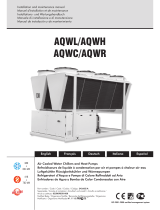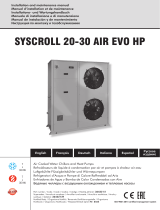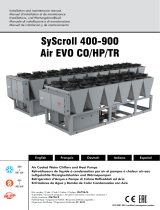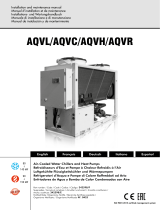
English
2SYSAQUA
CONTENTS
1. GENERAL RECOMMENDATIONS ........................................................................................................................................................ 3
1.1. SAFETY DIRECTIONS .......................................................................................................................................................................................................................3
1.2. WARNING ......................................................................................................................................................................................................................................... 3
1.3. EQUIPMENT SAFETY DATA ............................................................................................................................................................................................................. 4
2. INSPECTION AND STORAGE .............................................................................................................................................................. 5
3. WARRANTY ...................................................................................................................................................................................... 5
4. PRESENTATION ................................................................................................................................................................................. 5
5. CONTENTS OF PACKAGE ................................................................................................................................................................... 6
5.1. OPTIONALS ACCESSORIES ..............................................................................................................................................................................................................6
6. DIMENSIONS .................................................................................................................................................................................... 6
7. HANDLING ........................................................................................................................................................................................ 6
7.1. NET WEIGHT ..................................................................................................................................................................................................................................... 6
7.2. GRAVITY CENTER POSITION ...........................................................................................................................................................................................................6
7.2.1. WITHOUT BUFFER TANK ............................................................................................................................................................................................................................................6
7.2.2. WITH BUFFER TANK ...................................................................................................................................................................................................................................................6
7.3. MANUTENTION GENERALITES ......................................................................................................................................................................................................6
7.3.1. HANDLING WITH A FORKLIFT ...................................................................................................................................................................................................................................7
7.3.2. HANDLING BY SLINGING ...........................................................................................................................................................................................................................................7
8. TECHNICAL SPECIFICATIONS ............................................................................................................................................................. 8
8.1. PHYSICAL CHARACTERISTICS ........................................................................................................................................................................................................8
8.2. REFRIGERATION SPECIFICATIONS .................................................................................................................................................................................................9
8.2.1. REFRIGERANT CIRCUIT DIAGRAM ............................................................................................................................................................................................................................9
8.2.2. REFRIGERANT CHARGE ..............................................................................................................................................................................................................................................9
8.2.3. FLUOROCARBON GAS REGULATIONS......................................................................................................................................................................................................................9
8.4. ELECTRIC SPECIFICATIONS............................................................................................................................................................................................................10
8.4.1. SYSAQUA WITH STANDARD FAN .......................................................................................................................................................................................................................... 10
8.4.2. SYSAQUA WITH HIGH-PRESSURE FAN ................................................................................................................................................................................................................. 10
8.3. OPERATING LIMITS ........................................................................................................................................................................................................................10
8.3.1. SYSAQUA.L/SYSAQUA.H COOLING MODE .......................................................................................................................................................................................................... 10
8.3.2. SYSAQUA.H HEATING MODE ................................................................................................................................................................................................................................. 10
9. INSTALLATION ................................................................................................................................................................................ 11
9.1. SITING THE INSTALLATION ...........................................................................................................................................................................................................11
9.1.1. PREVAILING WIND ................................................................................................................................................................................................................................................... 11
9.1.2. CONDENSATE WATER MANAGEMENT IN HEATING MODE................................................................................................................................................................................ 11
9.1.3. HOW TO REDUCE NOISE POLLUTION .................................................................................................................................................................................................................... 11
9.2. CLEARANCE ....................................................................................................................................................................................................................................12
9.3. ATTACHMENT TO THE GROUND ..................................................................................................................................................................................................12
10. HYDRAULIC LINKS ........................................................................................................................................................................ 13
10.1. MAIN HYDRAULIC CIRCUIT ........................................................................................................................................................................................................13
10.2. ANTI-CLOGGING PROTECTION ..................................................................................................................................................................................................13
10.3. MINIMUM WATER VOLUME REQUIREMENTS..........................................................................................................................................................................14
10.3.1. SYSAQUA COOLING ONLY VERSION ................................................................................................................................................................................................................... 14
10.3.2. SYSAQUA HEAT PUMP VERSION .........................................................................................................................................................................................................................14
10.4. MAXIMUM WATER VOLUME REQUIREMENTS ........................................................................................................................................................................14
10.5. RINSING THE CIRCUIT .................................................................................................................................................................................................................14
10.6. FROST PROTECTION ...................................................................................................................................................................................................................15
10.7. WATER QUALITY ..........................................................................................................................................................................................................................16
10.8. HEAT INSULATION .......................................................................................................................................................................................................................17
10.9. FILLING THE SYSTEM WITH WATER .......................................................................................................................................................................................... 17
11. WIRING DIAGRAM AND LEGEND .................................................................................................................................................. 18
11.1. WIRING DIAGRAM ......................................................................................................................................................................................................................18
11.2. LEGEND ........................................................................................................................................................................................................................................18
11.2.1. POWER SUPPLY ..................................................................................................................................................................................................................................................... 18
11.2.2. WIRING DIAGRAM KEY DESCRIPTIONS .............................................................................................................................................................................................................. 18
11.2.3. RANGE AND SETTINGS OF THEMAL PROTECTION / NOMINAL INTENSITY OF THE CONTACTORS (CLASSE AC3) .................................................................................. 18
12. ELECTRICAL CONNECTIONS ........................................................................................................................................................... 19
12.1. SYSAQUA 20 - 25 - 30 - 35 - 40 ............................................................................................................................................................................................20
12.2. OPTIONS ALL SEASONS AND VARIABLE FLOW PUMP ..........................................................................................................................................................21
13. REGULATION ................................................................................................................................................................................ 22
13.1. ORDER OF PRIORITY FOR CONTROL SYSTEMS .......................................................................................................................................................................22
13.2. USER INTERFACE .........................................................................................................................................................................................................................22
13.2.1. KEYPAD................................................................................................................................................................................................................................................................... 22
13.2.2. HOME PAGE ........................................................................................................................................................................................................................................................... 23
13.2.3. MAIN MENU .......................................................................................................................................................................................................................................................... 23
13.2.4. MENUS.................................................................................................................................................................................................................................................................... 23
13.3. INITIAL SETTINGS ........................................................................................................................................................................................................................24
13.3.1. TIME SETTINGS ...................................................................................................................................................................................................................................................... 24
13.3.2. LANGUAGE SETTINGS...........................................................................................................................................................................................................................................24
13.3.3. DEFINING THE GLYCOL RATE ............................................................................................................................................................................................................................... 25
13.4. LAUNCHING THE SYSAQUA SYSTEM........................................................................................................................................................................................25
13.4.1. CONFIGURING INPUT D1 ...................................................................................................................................................................................................................................... 25
13.4.2. CONFIGURING INPUT D2 ...................................................................................................................................................................................................................................... 26
13.4.3. HEAT/COOL SELECTION ........................................................................................................................................................................................................................................ 26
13.4.4. SELECTING THE OPERATING MODE .................................................................................................................................................................................................................... 27
13.4.5. USER TEMPERATURE SETPOINTS AND ACTUAL SETPOINTS ........................................................................................................................................................................... 27
13.4.6. WATER LAW ........................................................................................................................................................................................................................................................... 28
13.4.7. "VARIABLE PRIMARY FLOW” OPTION ...............................................................................................................................................................................................................30
13.4.8. REDUCED MODE .................................................................................................................................................................................................................................................... 33
13.4.9. LIMITED CAPACITY ................................................................................................................................................................................................................................................ 33
13.5. ALARMS .......................................................................................................................................................................................................................................34
13.6. SCHEDULE ....................................................................................................................................................................................................................................35
14. COMMISSIONING ..........................................................................................................................................................................36
14.1. PRE-START CHECK LIST ..............................................................................................................................................................................................................36
14.1.1. VISUAL CHECK ....................................................................................................................................................................................................................................................... 36
14.1.2. ELECTRICAL CHECK ............................................................................................................................................................................................................................................... 36
14.1.3. HYDRAULIC CHECK ................................................................................................................................................................................................................................................ 36
14.2. OPERATING CHECK LIST .............................................................................................................................................................................................................37
14.2.1. GENERAL ................................................................................................................................................................................................................................................................ 37
14.2.2. PHASE ROTATION PROTECTION .......................................................................................................................................................................................................................... 37
14.2.3. ELECTRICAL ............................................................................................................................................................................................................................................................ 37
14.2.4. HYDRAULIC CIRCUIT .............................................................................................................................................................................................................................................. 37
14.2.5. COMPRESSOR AND REFRIGERATION SYSTEM .................................................................................................................................................................................................. 38
14.2.6. FINAL CHECK .......................................................................................................................................................................................................................................................... 38
15. IN CASE OF WARRANTY - MATERIAL RETURN PROCEDURE .........................................................................................................38
16. ORDERING SERVICE AND SPARE PARTS ORDER ...........................................................................................................................38
17. MAINTENANCE .............................................................................................................................................................................39
17.1. WEEKLY CHECK ............................................................................................................................................................................................................................39
17.2. PERIODIC TABLE OF SERVICE AND MAINTENANCE ...............................................................................................................................................................40
17.3. MAINTENANCE PROCEDURES ...................................................................................................................................................................................................42
17.3.1. REFRIGERANT CIRCUIT ..........................................................................................................................................................................................................................................42
17.3.2. HYDRAULIC CIRCUIT .............................................................................................................................................................................................................................................. 43
17.3.3. WINTER PROTECTION .......................................................................................................................................................................................................................................... 43
18. TROUBLE SHOOTING .....................................................................................................................................................................44




























